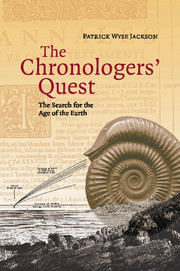Book contents
- Frontmatter
- Contents
- List of illustrations
- List of tables
- Preface
- Acknowledgements
- 1 The ancients: early chronologies
- 2 Biblical calculations
- 3 Models of Aristotelian infinity and sacred theories of the Earth
- 4 Falling stones, salty oceans, and evaporating waters: early empirical measurements of the age of the Earth
- 5 Thinking in layers: early ideas in stratigraphy
- 6 An infinite and cyclical Earth and religious orthodoxy
- 7 The cooling Earth
- 8 Stratigraphical laws, uniformitarianism and the development of the geological column
- 9 ‘Formed stones’ and their subsequent role in biostratigraphy and evolutionary theory
- 10 The hour-glass of accumulated or denuded sediments
- 11 Thermodynamics and the cooling Earth revisited
- 12 Oceanic salination reconsidered
- 13 Radioactivity: invisible geochronometers
- 14 The Universal problem and Duck Soup
- Bibliography
- Index
8 - Stratigraphical laws, uniformitarianism and the development of the geological column
Published online by Cambridge University Press: 02 December 2009
- Frontmatter
- Contents
- List of illustrations
- List of tables
- Preface
- Acknowledgements
- 1 The ancients: early chronologies
- 2 Biblical calculations
- 3 Models of Aristotelian infinity and sacred theories of the Earth
- 4 Falling stones, salty oceans, and evaporating waters: early empirical measurements of the age of the Earth
- 5 Thinking in layers: early ideas in stratigraphy
- 6 An infinite and cyclical Earth and religious orthodoxy
- 7 The cooling Earth
- 8 Stratigraphical laws, uniformitarianism and the development of the geological column
- 9 ‘Formed stones’ and their subsequent role in biostratigraphy and evolutionary theory
- 10 The hour-glass of accumulated or denuded sediments
- 11 Thermodynamics and the cooling Earth revisited
- 12 Oceanic salination reconsidered
- 13 Radioactivity: invisible geochronometers
- 14 The Universal problem and Duck Soup
- Bibliography
- Index
Summary
EMERGENCE OF PROFESSIONALISM IN GEOLOGY
By 1800 a new breed of geologist had emerged – the professional. This term includes several groups of people drawn to the discipline: the academics in universities; those who derived their livelihood through working as geologists, mining engineers or surveyors; and those who could support their geological work pretty well full-time through their own means. Into the first of these three categories we can place Adam Sedgwick (1785–1873) of Cambridge (Figure 8.1) and the Reverend William Buckland (1784–1856) of Oxford and later Dean of Westminster; into the second, the army man Joseph Ellison Portlock (1794–1864), and the Local Director of the Geological Survey in Ireland Joseph Beete Jukes (1811–1869); and into the third, Roderick Impey Murchison (1792–1871) (Figure 8.2) and Charles Lyell (1795–1875) (Figure 8.3), to name but six. This emergence generated the momentum that saw the adolescent discipline of geology mature into a fully fledged science, complete with its own professional bodies and surveys and a work force that advanced its understanding and knowledge base. The Geological Society of London was established in 1807 and was followed by other specialist geological societies, including that in Dublin (1831). A chair of Geology was endowed in Cambridge in 1728 by John Woodward, and similar chairs were established in University College London in 1841, and in the University of Dublin in 1843. Government geological surveys began the official mapping of vast tracts of land in the hope of returning economically viable materials.
- Type
- Chapter
- Information
- The Chronologers' QuestThe Search for the Age of the Earth, pp. 119 - 153Publisher: Cambridge University PressPrint publication year: 2006



